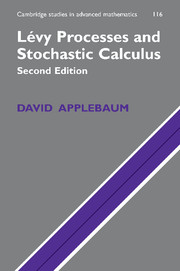Book contents
- Frontmatter
- Contents
- Preface to Second Edition
- Preface
- Overview
- Notation
- 1 Lévy processes
- 2 Martingales, stopping times and random measures
- 3 Markov processes, semigroups and generators
- 4 Stochastic integration
- 5 Exponential martingales, change of measure and financial applications
- 6 Stochastic differential equations
- References
- Index of notation
- Subject index
6 - Stochastic differential equations
Published online by Cambridge University Press: 25 January 2011
- Frontmatter
- Contents
- Preface to Second Edition
- Preface
- Overview
- Notation
- 1 Lévy processes
- 2 Martingales, stopping times and random measures
- 3 Markov processes, semigroups and generators
- 4 Stochastic integration
- 5 Exponential martingales, change of measure and financial applications
- 6 Stochastic differential equations
- References
- Index of notation
- Subject index
Summary
Summary After a review of first-order differential equations and their associated flows, we investigate stochastic differential equations (SDEs) driven by Brownian motion and an independent Poisson random measure. We establish the existence and uniqueness of solutions under the standard Lipschitz and growth conditions, using the Picard iteration technique. We then turn our attention to investigating properties of the solution. These are exhibited as stochastic flows and as multiplicative cocycles. The interlacing structure is established, and we prove the continuity of solutions as a function of their initial conditions. We then show that solutions of SDEs are Feller processes and compute their generators. Perturbations are studied via the Feynman–Kac formula. We briefly survey weak solutions and associated martingale problems. The existence of Lyapunov exponents for solutions of SDES will be investigated.
Finally, we study solutions of Marcus canonical equations and discuss the respective conditions under which these yield stochastic flows of homeomorphisms and diffeomorphisms.
One of the most important applications of Itô's stochastic integral is in the construction of stochastic differential equations (SDEs). These are important for a number of reasons.
(1) Their solutions form an important class of Markov processes where the infinitesimal generator of the corresponding semigroup can be constructed explicitly. Important subclasses that can be studied in this way include diffusion and jump-diffusion processes.
(2) Their solutions give rise to stochastic flows, and hence to interesting examples of random dynamical systems.
(3) They have many important applications to, for example, filtering, control, finance and physics.
Information
- Type
- Chapter
- Information
- Lévy Processes and Stochastic Calculus , pp. 354 - 430Publisher: Cambridge University PressPrint publication year: 2009
